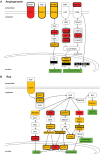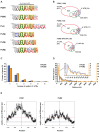Comparative analysis of mRNA targets for human PUF-family proteins suggests extensive interaction with the miRNA regulatory system
- PMID: 18776931
- PMCID: PMC2522278
- DOI: 10.1371/journal.pone.0003164
Comparative analysis of mRNA targets for human PUF-family proteins suggests extensive interaction with the miRNA regulatory system
Abstract
Genome-wide identification of mRNAs regulated by RNA-binding proteins is crucial to uncover post-transcriptional gene regulatory systems. The conserved PUF family RNA-binding proteins repress gene expression post-transcriptionally by binding to sequence elements in 3'-UTRs of mRNAs. Despite their well-studied implications for development and neurogenesis in metazoa, the mammalian PUF family members are only poorly characterized and mRNA targets are largely unknown. We have systematically identified the mRNAs associated with the two human PUF proteins, PUM1 and PUM2, by the recovery of endogenously formed ribonucleoprotein complexes and the analysis of associated RNAs with DNA microarrays. A largely overlapping set comprised of hundreds of mRNAs were reproducibly associated with the paralogous PUM proteins, many of them encoding functionally related proteins. A characteristic PUF-binding motif was highly enriched among PUM bound messages and validated with RNA pull-down experiments. Moreover, PUF motifs as well as surrounding sequences exhibit higher conservation in PUM bound messages as opposed to transcripts that were not found to be associated, suggesting that PUM function may be modulated by other factors that bind conserved elements. Strikingly, we found that PUF motifs are enriched around predicted miRNA binding sites and that high-confidence miRNA binding sites are significantly enriched in the 3'-UTRs of experimentally determined PUM1 and PUM2 targets, strongly suggesting an interaction of human PUM proteins with the miRNA regulatory system. Our work suggests extensive connections between the RBP and miRNA post-transcriptional regulatory systems and provides a framework for deciphering the molecular mechanism by which PUF proteins regulate their target mRNAs.
Conflict of interest statement
Figures





Similar articles
-
Ribonomic analysis of human Pum1 reveals cis-trans conservation across species despite evolution of diverse mRNA target sets.Mol Cell Biol. 2008 Jun;28(12):4093-103. doi: 10.1128/MCB.00155-08. Epub 2008 Apr 14. Mol Cell Biol. 2008. PMID: 18411299 Free PMC article.
-
PUM1 and PUM2 exhibit different modes of regulation for SIAH1 that involve cooperativity with NANOS paralogues.Cell Mol Life Sci. 2019 Jan;76(1):147-161. doi: 10.1007/s00018-018-2926-5. Epub 2018 Sep 29. Cell Mol Life Sci. 2019. PMID: 30269240 Free PMC article.
-
Evolutionary Conservation and Diversification of Puf RNA Binding Proteins and Their mRNA Targets.PLoS Biol. 2015 Nov 20;13(11):e1002307. doi: 10.1371/journal.pbio.1002307. eCollection 2015. PLoS Biol. 2015. PMID: 26587879 Free PMC article.
-
The PUF family of RNA-binding proteins: does evolutionarily conserved structure equal conserved function?IUBMB Life. 2003 Jul;55(7):359-66. doi: 10.1080/15216540310001603093. IUBMB Life. 2003. PMID: 14584586 Review.
-
The PUF Protein Family: Overview on PUF RNA Targets, Biological Functions, and Post Transcriptional Regulation.Int J Mol Sci. 2018 Jan 30;19(2):410. doi: 10.3390/ijms19020410. Int J Mol Sci. 2018. PMID: 29385744 Free PMC article. Review.
Cited by
-
LINC00857 promotes cell proliferation and migration in colorectal cancer by interacting with YTHDC1 and stabilizing SLC7A5.Oncol Lett. 2021 Aug;22(2):578. doi: 10.3892/ol.2021.12839. Epub 2021 Jun 2. Oncol Lett. 2021. PMID: 34122629 Free PMC article.
-
Rewiring of posttranscriptional RNA regulons: Puf4p in fungi as an example.Mol Biol Evol. 2012 Sep;29(9):2169-76. doi: 10.1093/molbev/mss085. Epub 2012 Mar 21. Mol Biol Evol. 2012. PMID: 22438588 Free PMC article.
-
A novel miRNA-mediated STOP sign in lung cancer: miR-340 inhibits the proliferation of lung cancer cells through p27(KIP1).Mol Cell Oncol. 2015 Feb 25;2(2):e977147. doi: 10.4161/23723556.2014.977147. eCollection 2015 Apr-Jun. Mol Cell Oncol. 2015. PMID: 27308439 Free PMC article.
-
The Role of Pumilio RNA Binding Protein in Plants.Biomolecules. 2021 Dec 9;11(12):1851. doi: 10.3390/biom11121851. Biomolecules. 2021. PMID: 34944494 Free PMC article. Review.
-
Pumilio-2 function in the mouse nervous system.PLoS One. 2011;6(10):e25932. doi: 10.1371/journal.pone.0025932. Epub 2011 Oct 7. PLoS One. 2011. PMID: 22016787 Free PMC article.
References
-
- Moore MJ. From birth to death: the complex lives of eukaryotic mRNAs. Science. 2005;309:1514–1518. - PubMed
-
- Dreyfuss G, Kim VN, Kataoka N. Messenger-RNA-binding proteins and the messages they carry. Nat Rev Mol Cell Biol. 2002;3:195–205. - PubMed
-
- St Johnston D. Moving messages: the intracellular localization of mRNAs. Nat Rev Mol Cell Biol. 2005;6:363–375. - PubMed
Publication types
MeSH terms
Substances
LinkOut - more resources
Full Text Sources
Molecular Biology Databases
Research Materials
Miscellaneous

